Authored by Harriet Kasidi Mugera , Jeffrey Tanner, Marco Tiberti & Clearance Tsimpo Nkengne
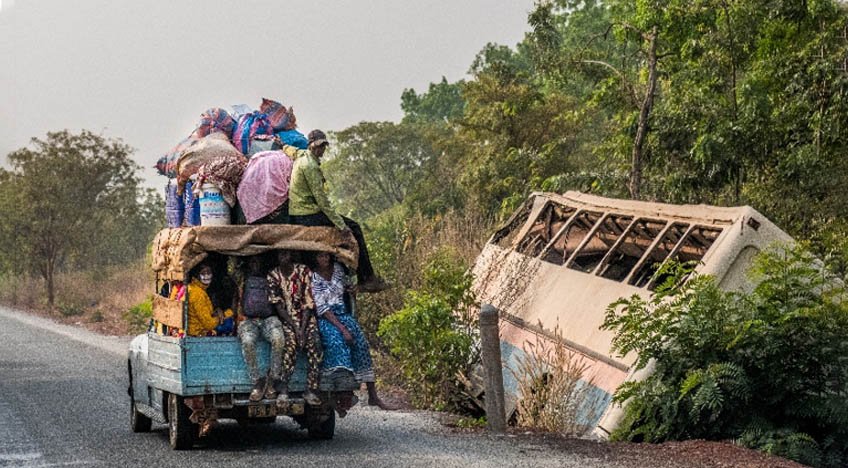
Photo:©Dorte Verner/World Bank
Along with other countries worldwide, Burkina Faso has been seriously impacted by the COVID-19 that was declared a pandemic by the World Health Organization (WHO) in March 2020. As of May 30th, 2022, a total of 20,899 cases were recorded in Burkina Faso. Unfortunately, many of the cases led to fatalities for a total number of deaths of 384 (1.8% of the cases). In Burkina Faso, the COVID-19 pandemic spread out at the peak of an unprecedented internal displacement crisis. Although the violence was initially triggered by exogenous factors related to regional dynamics, current conflict risks are the result of both the rise in regional violent extremism and deep-rooted structural causes. In particular, the sharp increase in the number of IDPs over the last three years is mainly attributable to the intensification of Jihadist attacks on civilians and security forces.[1] For security-related issues, in Burkina Faso forcibly displaced persons (FDPs) are predominantly internally displaced people (IDPs). According to the Conseil National de Secours d’Urgence et de Réhabilitation (CONASUR) estimates, the number of internally displaced people soared from 87,000 in January 2019 to over 1,7 million in January 2022. The unprecedented levels of displacement, occurring as the coronavirus pandemic was worsening an already critical humanitarian crisis in the violence-stricken country, called for the urgent need for timely data and analysis to better inform policy and targeting programs.
The Burkina Faso National Institute of Statistics and Demography (INSD), with the financial and technical support from the Joint World Bank – UNHCR Joint Data Center on Forced Displacement (JDC) and the technical assistance from the World Bank’s Poverty and Equity Global Practice and the Living Standards Measurement Study (LSMS) program, implemented and disseminated the data and survey briefs for the first two rounds of the High-Frequency Phone Survey (BFA HFPS-IDP).
The BFA HFPS-IDP was designed to assess the socioeconomic effects of the COVID-19 pandemic on Internally Displaced People (IDPs) and was conducted in three rounds between May and July 2021 conjointly for IDPs and the rest of the (non-IDP) population in the country, allowing for an assessment of potential differences in the experience of the displaced and non-displaced during the pandemic. Rounds 1, 2, and 3 of data collection for the HFPS-IDP occurred simultaneously with rounds 9, 10, and 11 of the national HFPS operation, respectively.
The core survey questionnaire of the Burkina Faso High-Frequency Phone Survey on IDPs (BFA HFPS-IDP) was designed to cover important and relevant topics like employment, access to basic services, and staple foods, food security, and non-labor sources of income. The core questionnaire was complemented by questions on selected topics that rotate each month, including knowledge of COVID-19 spread, social distancing, and behavior, coping mechanisms to shocks, fragility, conflict, and violence. Selected topics were investigated more in detail in specific rounds.
This note presents selected results from the first two rounds of the BFA HFPS-IDP data (round 3 results will be published soon). To access the BFA HFPS-IDP microdata and related documentation (questionnaire, technical document, and result briefs), please visit the World Bank’s Microdata Catalog here (microdata for the non-displaced population can be found here).
Food insecurity is particularly pronounced among IDPs—internally displaced households are nearly 50 percentage points more likely to be moderately or severely food insecure than the general Burkinabe population (May 2021 round). Combining households who are moderately food insecure and those severely food insecure makes it clear that food insecurity is more prevalent in rural areas for IDP and non-displaced households.
Figure 1: Food Insecurity Experience Scale
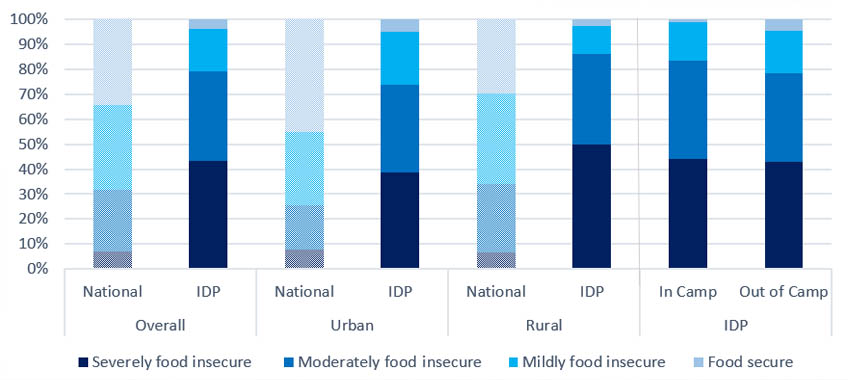
Employment outcome disparities are only slightly less vast (May 2021 round). In the week preceding data collection, eight in ten non-displaced respondents were employed, yet only five in ten IDP respondents were working over the same period. The employment rate is slightly higher (although not significant) for out-of-camp IDPs (53.2%) than for camped IDPs (48.5%).
Figure 2: Employment status of respondents (last 7 days)
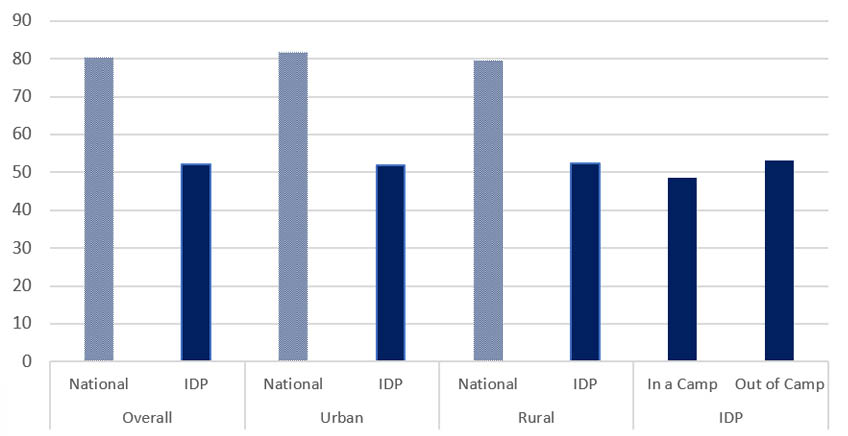
The economic slowdown due to COVID-19 has translated into an economy-wide reduction in income. Across all subgroups, most respondents reported falling incomes over the last year. (May 2021 round).
Figure 3: Income change compared to April 2020
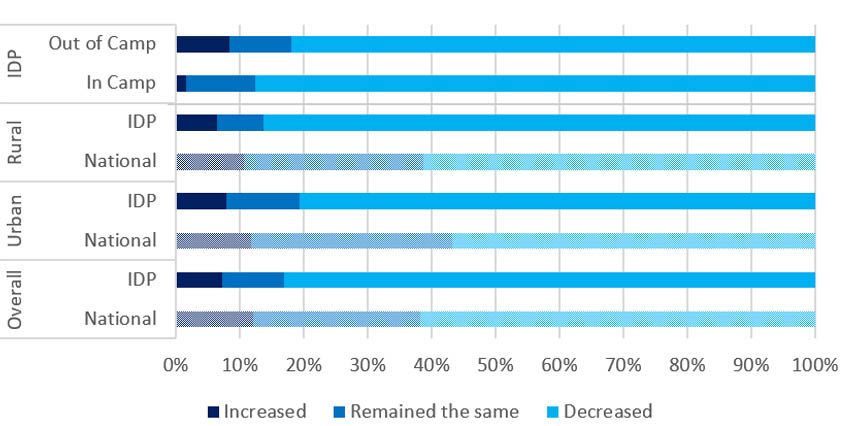
Displaced households have very different income source profiles from the general population. Non-displaced households get their income mainly from non-farm enterprises (37.6%), and farm activities (26.1%) (May 2021 round). On the other hand, most IDPs (57.1%) receive family and non-family assistance—including remittances from abroad; income from non-farm enterprises is the most frequent source of labor income (24.4%). IDPs living in camp are highly reliant on family and non-family assistance (including remittances from abroad), while those living out of a camp are more likely to engage in non-farm business.
Figure 4: Households’ main income sources
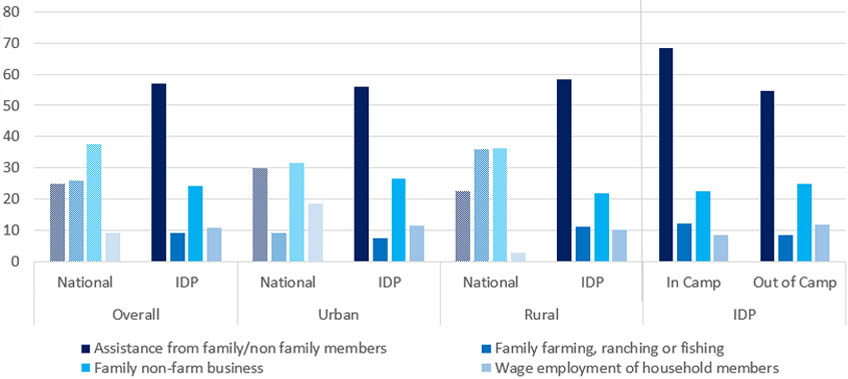
of households who did not have all their children return to school (June 2021 round).
Figure 5: Households that sent their children to school after school reopening
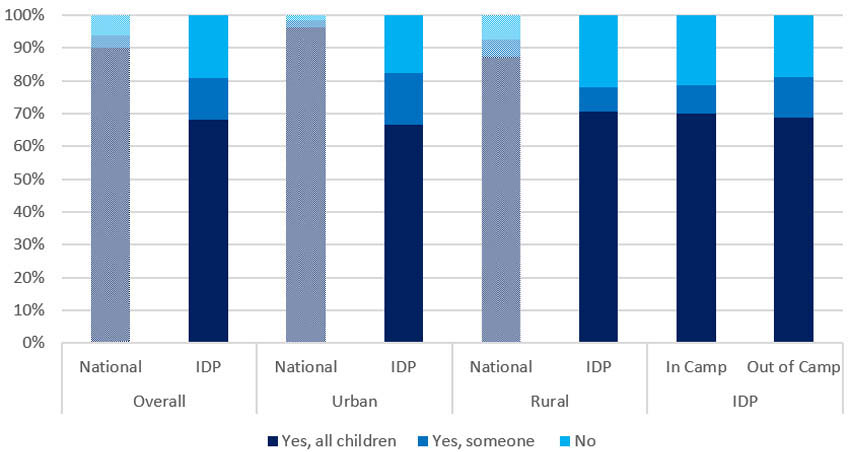
During the pandemic and displacement crises, access to financial services has been severely limited for both IDPs and the Burkina population generally. Over the survey period, informal sources such as friends and relatives were virtually the only source of credit for IDP households (not shown), and displaced households borrowed mainly to purchase food products (68%) (June 2021 round).
Figure 6: Main reason for borrowing financial resources
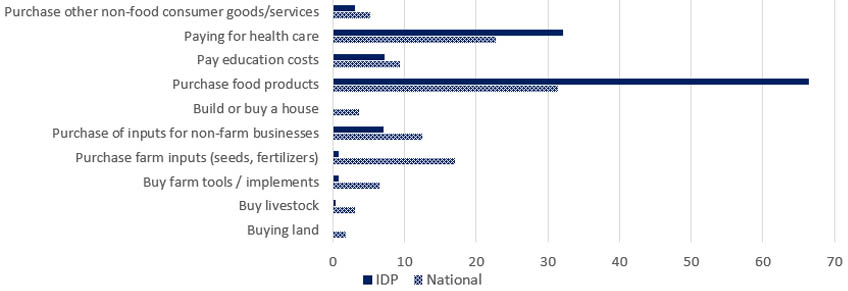
IDP households coped with shocks in very different ways than the general Burkinabe population. Nationally, most households reported that they rely on savings, selling assets, or friends for help. Displaced Burkinabe households rely on friends, too, but primarily look to government and non-government organizations, suggesting that the displaced may have already lost savings and assets (June 2021 round).
Figure 7: Households’ coping strategies to shocks adopted in the previous 2 months

The members of the team working on the BFA HFPS-IDP are Marco Tiberti, Clarence Tsimpo Nkengne, and Marco Costantini from the World Bank, Harriet Mugera and Jeff Tanner from the WB-UNHCR Joint Data Center on Forced Displacement (JDC) and Zakaria Koncobo from the Institut National de la Statistique et la Demographie (INSD). The team benefitted from the comments by Maja Lazic (UNHCR). The briefs were prepared with guidance from Björn Erik Gillsater (JDC), Johan A. Mistiaen (World Bank), Boureima Ouedraogo, and Jean Edouard Odilon Doamba (INSD). The team acknowledges the essential support of CONASUR in providing the sampling frame.
[1]. For more details: https://www.unhcr.org/fr/news/briefing/2021/7/60fa9509a/nombre-personnes-forcees-fuir-violences-cours-burkina-faso-atteint-niveau.html
This blog first appeared on the World Bank’s website.


